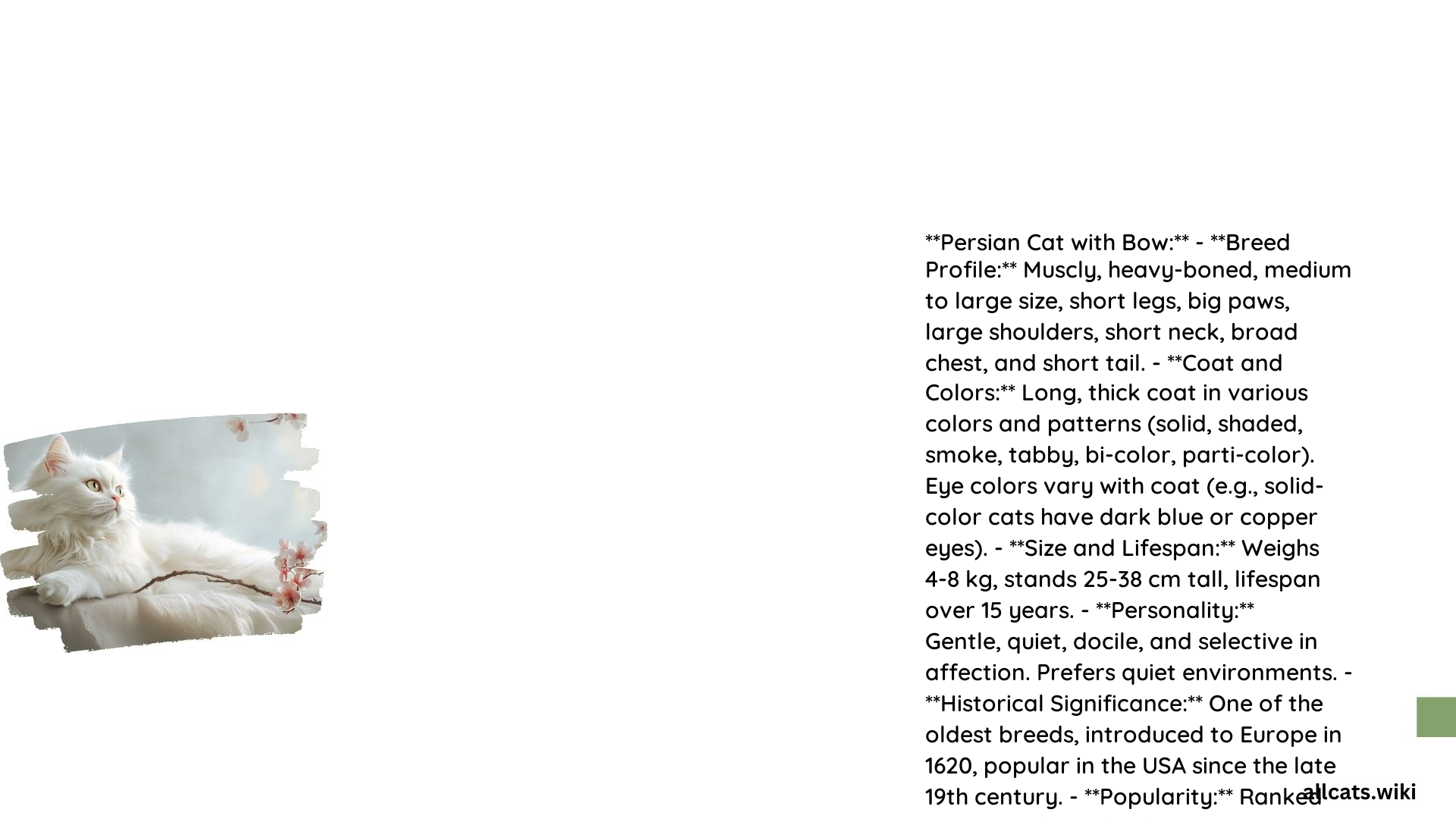What are the Key Physical Characteristics of a Persian Cat With Bow?

A Persian cat with a bow is a charming and adorable feline companion. These cats are known for their distinctive physical features, including a round, flat face, large eyes, and a long, luxurious coat. Here are the key physical characteristics of a Persian cat with a bow:
-
Body Type and Size: Persian cats are medium to large in size, with a sturdy, muscular build. They typically weigh between 7 to 12 pounds and measure 14 to 17 inches in length. Their short, muscular legs and deep chest give them a compact, well-proportioned appearance.
-
Coat Texture and Color: The most striking feature of a Persian cat is its long, thick, and silky coat. The coat stands off from the body, giving the cat a fluffy, round appearance. Persian cats come in a wide range of colors, including solid, tabby, tortoiseshell, bicolor, and various patterns such as smoke and shaded. Common colors include blue, black, white, red, cream, chocolate, lilac, silver, and golden.
-
Eye Shape and Color: Persian cats have large, round eyes that are set wide apart, giving them a sweet and endearing expression. The eye colors can be copper, blue, green, blue-green, hazel, and odd-eyed.
-
Facial Structure: The face of a Persian cat is round and flat, with a short, snub nose and full cheeks. The muzzle is not overly pronounced, smoothing into the cheeks. The chin is full and well-developed, reflecting a proper bite. The ears are small, round-tipped, and set far apart.
How to Care for a Persian Cat With Bow?

Caring for a Persian cat with a bow requires a significant amount of grooming and attention to their specific needs. Here’s what you need to know:
-
Grooming Routines: Persian cats require extensive grooming to prevent matting and tangling of their long coat. Daily combing with a wide-toothed metal comb and brushing with a soft slicker brush are necessary. Regular bathing is also required, followed by careful drying with a pet hair dryer. Daily face washing and weekly nail trimming are also essential.
-
Feeding Schedules: Feed measured meals twice a day to prevent overeating and obesity. Young kittens should eat three times a day. Consult with a veterinarian for specific dietary advice.
-
Environmental Needs: Persian cats are homebodies and prefer to stay indoors to avoid overheating and coat damage. Provide a comfortable and safe environment with approved scratching areas to encourage natural scratching behavior.
What are the Common Health Issues and Preventive Measures for a Persian Cat With Bow?
Persian cats, including those with bows, are prone to certain health issues due to their brachycephalic (flat-faced) structure. Here are some common health concerns and preventive measures:
-
Genetic Predispositions: Persian cats are prone to genetic issues due to their flat-faced structure. This can lead to respiratory problems, dental malalignment, and eye conditions such as tearing and conjunctivitis.
-
Respiratory Problems: The flat face of Persian cats can cause narrowing of the nasal airways and nostrils, leading to breathing difficulties. Regular veterinary check-ups and maintaining a healthy weight can help mitigate these issues.
-
Eye Conditions: The large, round eyes of Persian cats are prone to tearing and other eye issues. Daily face washing and regular veterinary check-ups can help prevent these conditions.
-
Preventive Measures and Treatment Options: Regular grooming and veterinary care are crucial for Persian cats with bows. Preventive measures include daily grooming, regular bathing, and ensuring the cat stays indoors. For respiratory issues, maintaining a healthy weight and providing a cool environment can help. For eye conditions, daily face washing and veterinary care are essential.
What are the Practical Information and Costs for Owning a Persian Cat With Bow?
Owning a Persian cat with a bow comes with some practical considerations and associated costs. Here’s what you need to know:
-
Grooming Tools: Invest in a wide-toothed metal comb, a soft slicker brush, and a pet hair dryer. These tools can range in cost from $20 to $100 depending on the quality and brand.
-
Diet: High-quality cat food suitable for Persian cats can cost between $50 to $100 per month depending on the brand and quantity.
-
Veterinary Care: Regular check-ups and preventive care can cost around $500 to $1,000 per year, depending on the frequency of visits and any necessary treatments.
Reference:
- Persian Cat: Breed Profile, Characteristics & Care by The Spruce Pets
-
Persian Cat: Breed Profile, Characteristics & Care – The Spruce Pets
-
Exotic Longhair Kittens vs Persian Kittens by Mon Cheri Cattery
-
Exotic Longhair Kittens vs Persian Kittens – Mon Cheri Cattery
-
Persian – Cat Fanciers’ Association
- Persian – Cat Fanciers’ Association.
